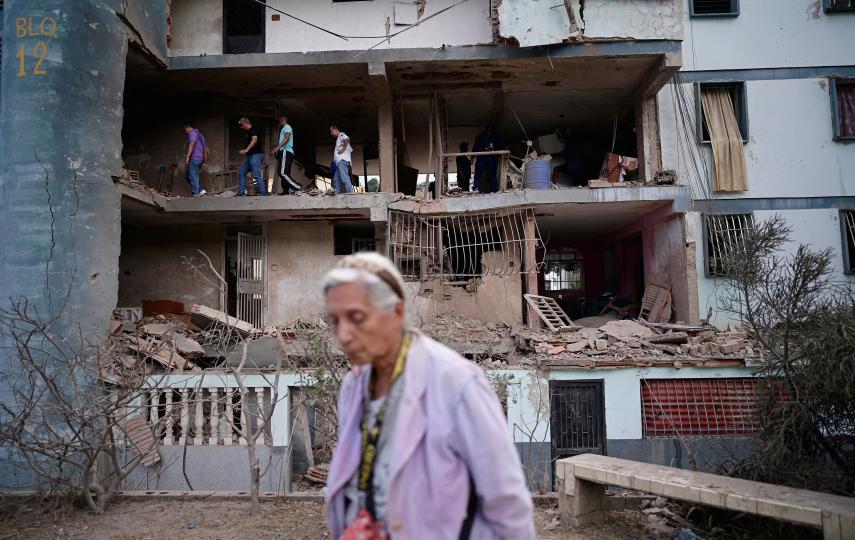Remember those 10 crises and trends to watch in 2019 we presented back in January? We’ve been keeping an eye on them, reporting on how areas from climate change to political transitions in South Sudan and the Democratic Republic of Congo are impacting humanitarian needs and response. With 2019 just about half over, it’s time for an update.
Here’s what’s changed over the past six months, what we’re paying special attention to, and how it may affect the lives and livelihoods of people on the ground. Look for two updates every day this week, including today's on Congo and South Sudan, and on outsourcing risk to local responders.
Be sure to share your thoughts – and ideas for our continuing coverage – at [email protected] or @newhumanitarian
2019 was supposed to have been a political year of promise for the Democratic Republic of Congo and South Sudan. Both were undergoing political transitions – in the case of the DRC a potentially seismic election, and in South Sudan a power-sharing government to cement a peace deal. Both events didn’t quite go to plan.
What's new:
In Congo, long-delayed elections to replace President Joseph Kabila – in power since 2001 – finally took place on 30 December. When the results were announced there was domestic and international uproar. Martin Fayulu, the man who all available independent evidence suggested had won, had officially lost. Sworn in instead was Felix Tshisekedi, who is believed to have benefitted from the influence out-going Kabila had with the national election body. Popular disappointment over Fayulu’s defeat is tempered by the fact that at least Tshisekedi is not Kabila. But Tshisekedi will struggle to impose himself against a system that Kabila built, linking powerful politicians and security chiefs to militia leaders in the mineral-rich and troubled east of the country. A government has yet to be sworn in, which complicates the engagement of the humanitarian community. Ebola is one critical issue. The outbreak in North Kivu and Ituri has not abated – despite an expanding vaccination programme – stoking fears of major cross-border epidemics. The Ebola response has been politicised, straining trust between the authorities, health workers, and the community in what is a Fayulu stronghold. Communal violence in the central and eastern regions; mass displacement; severe food insecurity; and cholera and measles epidemics, have left almost 13 million people in need of assistance.
In South Sudan a transitional power-sharing government to end a five-year war was meant to have been installed in May, but instead has been delayed to November. There were a number of unimplemented sticking points to the peace deal between President Salva Kiir and rebel leader Riek Machar that it is hoped the delay will resolve. The conflict has killed almost 400,000 people, displaced millions, and plunged pockets of the country into famine. Although the truce is largely holding, the country remains divided between government and rebel-held areas, which complicates humanitarian access. And while security has improved in the capital, Juba, there are still plenty of local conflicts dismissed as “cattle raiding” or “revenge killings” that clearly have a political root. A unified national army and agreement on state boundaries are key issues to be implemented in the coming months, but the fact that both sides have continued to recruit does not augur well for the November deadline. That fuels some scepticism over whether this power-sharing government will work when two others – based on the same formula of dividing up national resources between the warlords – did not. In the meantime, South Sudan’s acute suffering continues. Almost seven million people – more than 60 percent of the population – are facing a critical lack of food, with famine once more forecast in some of the most isolated areas.
Why we’re watching:
South Sudan and the DRC are two of the world's largest humanitarian crises, displacing more than 10 million people between them. Political change could yield more peaceful conditions on the ground.
Keep in mind:
The extent of displacement and food insecurity in South Sudan and the large number of conflicts in Congo amount to a scale of humanitarian crisis only matched by Syria and Yemen. In dollars and cents, South Sudan’s $1.51 billion donor appeal is only 38.2 percent funded and Congo’s $1.65 billion appeal (excluding Ebola) is so far only 21.5 percent funded.*
(*An earlier version of this story used incorrect number for the status of both the South Sudan and Congo appeals.)
(TOP PHOTO: Internally displaced people in Kuda, a village 45 kilometres west of Juba, South Sudan.)




